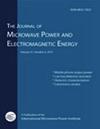功率输入和食品长宽比对商用烤箱冷冻食品微波解冻过程的影响
IF 0.9
4区 工程技术
Q4 ENGINEERING, CHEMICAL
Journal of Microwave Power and Electromagnetic Energy
Pub Date : 2019-10-02
DOI:10.1080/08327823.2019.1677430
引用次数: 12
摘要
摘要采用数值和实验相结合的方法,研究了微波加热过程中功率电平和宽高比的影响。样品为粥冻米。在COMSOL Multiphysics软件中建立了求解麦克斯韦方程和傅立叶热方程的三维有限元模型。模拟的温度结果与光纤传感器测量五个位置温度的实验结果相吻合。红外摄像机捕捉到了表面温度。结果表明,瞬态温度的RMSE值在6.14 ~ 12.88℃之间。计算得到的温度曲线与300 s加热的温度曲线吻合较好。此外,在较高的功率水平(1300 ~ 1800 W)下,升温速率增加了27%,样品的长宽比发生了显著的变化,均匀性发生了变化。最后,研究的预期结果将提供一个概念框架,关键参数,微波炉适用于特定冷冻食品及其包装的温度分布。本文章由计算机程序翻译,如有差异,请以英文原文为准。
Effects of power input and food aspect ratio on microwave thawing process of frozen food in commercial oven
Abstract This research studied the effects of power level and aspect ratio by numerical and experimental analysis in the microwave heating process. The sample was congee frozen rice. A three-dimensional model developed to solve Maxwell’s equations and Fourier’s heat equations using the finite element method in COMSOL Multiphysics software. The simulated temperature results were validated experimental results to measure five locations temperature by fibre-optic sensors. The surface temperature was captured by an infrared camera. From the results, the RMSE values of transient temperature were between ranges of 6.14 and 12.88 °C. The calculated temperature contours were in a good agreement for the 300-s heating. In addition, the increasing heating rate was 27% at the higher power level (1300–1800 W). The aspect ratio of sample change was significant change uniformity occurred. Finally, the expected results from the study will provide a conceptual framework, critical parameters, and distribution of microwave oven applicable temperature for specific frozen food and its packing.
求助全文
通过发布文献求助,成功后即可免费获取论文全文。
去求助
来源期刊

Journal of Microwave Power and Electromagnetic Energy
ENGINEERING, CHEMICAL-ENGINEERING, ELECTRICAL & ELECTRONIC
CiteScore
2.50
自引率
6.70%
发文量
21
期刊介绍:
The Journal of the Microwave Power Energy (JMPEE) is a quarterly publication of the International Microwave Power Institute (IMPI), aimed to be one of the primary sources of the most reliable information in the arts and sciences of microwave and RF technology. JMPEE provides space to engineers and researchers for presenting papers about non-communication applications of microwave and RF, mostly industrial, scientific, medical and instrumentation. Topics include, but are not limited to: applications in materials science and nanotechnology, characterization of biological tissues, food industry applications, green chemistry, health and therapeutic applications, microwave chemistry, microwave processing of materials, soil remediation, and waste processing.
 求助内容:
求助内容: 应助结果提醒方式:
应助结果提醒方式:


